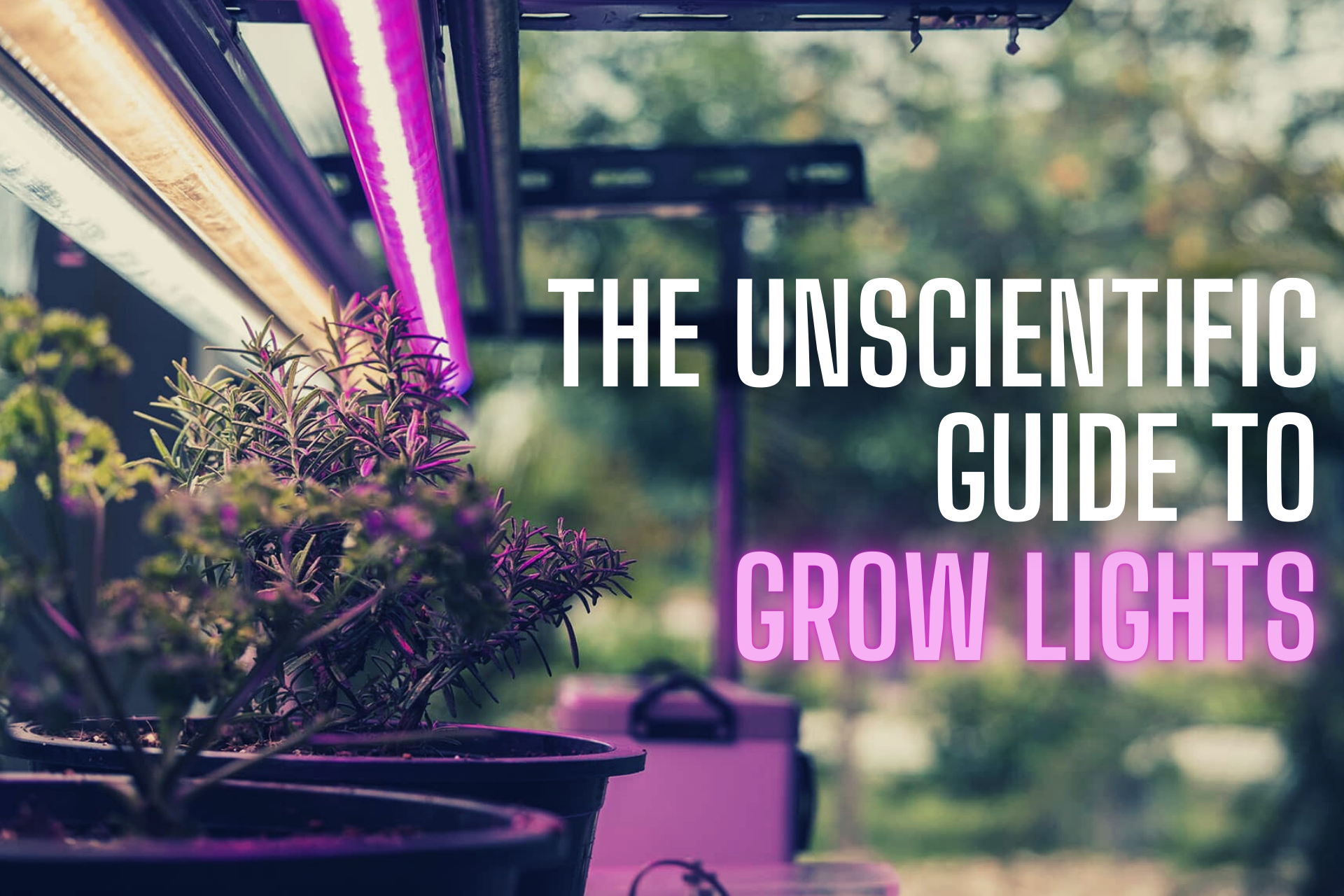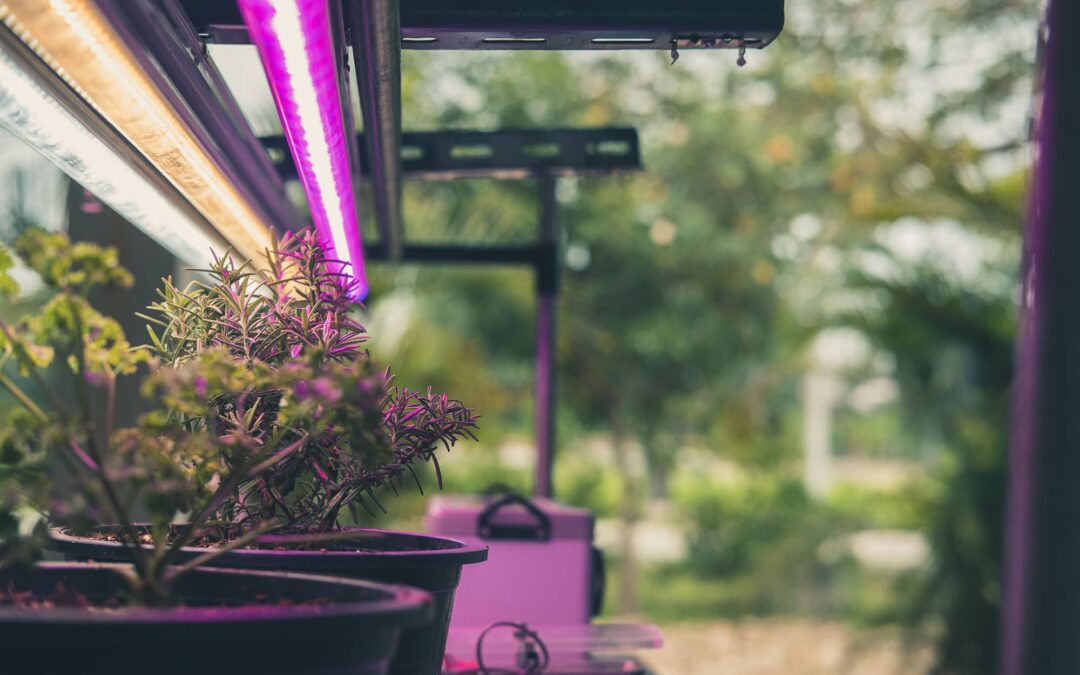
If you have Googled “grow lights,” you may feel like you’ve left the flower department and entered the lighting center in the hardware store. Lumens, spectrum, watts, LED, HID… if your head is spinning, you aren’t alone! So, why is it worth muddling through the scientific jargon? How do you select the right grow light? And how do you use it? Find the answers here!
Why Are Grow Lights Beneficial?
Whether you’re bringing your herb-babies in for the winter or starting new, grow lights can help you successfully grow plants indoors. And, really, who doesn’t want fresh smelling, edible herbs at their fingertips year-round?
It’s no secret: to flourish, all plants have specific needs that must be met. Even shade-loving herbs still require light to function! So, the grow light journey begins with appreciating what our Sun does for us every day:
- Energy: (aka Photosynthesis) Sunlight transforms into energy!
- Day/Night: (aka Photoperiodism) Just like us, plants need specific hour cycles of daylight and darkness. We have to go to bed sometime!
- Flavor: UV Rays, which can be harmful to people, are beneficial to herbs! For one thing, they stimulate the production of essential oils, which = flavor. No one wants bland Basil!
- Warmth: The Sun provides heat to keep herbs growing.
- Consistent Growth: We’ve all seen weak, stringy, leggy plants. This is usually caused by insufficient light. Appropriate sunlight helps your herbs grow healthy, beautifully lush crops!
As an edible-plant parent, there are probably a few things you want to get out of the relationship: (1) a usable amount of herbs and (2) delicious flavor. Grow Lamps are a form of artificial light that mimics natural outdoor lighting. So, if you’re short on Sun, you can purchase a grow light to reach those same goals.
How Can I Choose the Best Grow Light?
Sadly, there is no one right solution! You have to figure out the answer yourself, based on your unique circumstances. You aren’t alone, though. Here are a few tips that will help out:
Your Plants
It makes sense that this is #1 on the list! Before you press “purchase” on Amazon for that new grow light, you need to think about:
- How many plants do I have?
- What light requirements do my plants have? Are they the same? Or not?
- What size are my herbs? How much will they grow in a season?
How Many
If you are looking to provide a grow light for one plant, the solution is relatively simple.
However, if you have a whole herb family you are trying to keep alive through the winter, things can get complicated. You may need numerous lamps to have enough light to spread around! (Keep reading for more on this later!)
Lighting Requirements
Again, providing light for one herb plant is going to be pretty straightforward. As long as you know what it needs, you can purchase one solution.
But, if you have an assortment of plants, you will need to determine the intensity of light each individual needs. Then you will need to separate the whole bunch into smaller categories. A few examples:
- High Sun: Basil, Chives, Marjoram, Oregano
- Part Sun: Bay Tree, Cilantro, Dill
- Low Sun: Parsley
You will also have to consider how many hours of artificial light your herbs need. For instance, while Basil and Rosemary have similar light intensity needs, their daylight cycle (aka Photoperiodism!) differs. Basil should get 12 hours of bright light, while Rosemary should only receive 8 hours.
Chances are, if you have an extensive collection of herbs, you may need more than one lamp. A stackable system where you can utilize different light intensities and durations will be your best bet. (Say goodbye to hassle… you can even purchase inexpensive timers to turn your lights on and off for you!)
Do your research! After you categorize your plant family by light intensity and light duration, you will be better equipped to select your perfect grow light (or lights).
Plant Size
There’s more to come on the science of grow lights later, but just know, the distance from your herbs to the grow light is an essential ingredient to successful indoor growing! In short, plant-lamp distance determines how much light your plant soaks in.
So, you will also need to group your collection according to current height (and expected height, for super-fast growers). As an example, if you have a 2-foot tall Rosemary and a 5-inch tall Thyme, guess who’s going to get the short end of the stick? You got it! If you want your herbs to grow consistently and yield a usable crop, the grow light needs to be at the optimum height for all!
Make sure to purchase a grow lamp that is fully adjustable, and remember to adjust your lamp’s distance as your plant grows! Don’t let it get too close. Your herbs could get scorched by the light!
How Far Should I Keep my Light from my Plants?
This depends on the type of light you choose. Lightbulbs let off heat, which can benefit your herbs. But too much can damage them. If you purchase a grow light kit, follow the instructions closely. But, if you’re DIY-ing, here are a few herb-light distances for commonly used lightbulbs:
- Incandescent: 24 inches
- Fluorescent: 12 inches
- LED: 6 inches
If your light-source is not listed above, don’t just guess, do research! Remember, your herbs will follow the light, so keep it directly above them at all times.
What Do I Need to Know About Grow Lights?
This is where the scientific & mathematic bits come in… but if you are browsing the Web for grow lamps, you need to know this stuff!
What is Spectrum? Which Spectrum is Beneficial to Herbs?
Natural light can be broken down into different parts, one of which is called “Spectrum.” Full-spectrum, white light consists of all the colors. But, broken down, it includes almost every color in the rainbow: red, orange, yellow, green, blue, indigo, and violet. Ok, don’t call Bill Nye the Science Guy yet… What do you need to take away from this list?
Full-Spectrum, white light, is the most useful multi-purpose light. It covers all of the different natural sunlight components and is sure to make your herb babies happy!
If you have to choose between spectrums, blue and red are two of the most critical for your herbs. Why? Blue light encourages the growth of foliage, while Red light encourages strong stems (and flowers).
What are Lumens? How Many Lumens Should I Choose?
It is vital that, when choosing a grow lamp or lightbulb, you select it by lumens. The term “Watts” describes the amount of power the bulb uses. “Lumen” defines the amount of light the bulb gives off.
Remember the light intensity categories from earlier? This is how many lumens each category needs:
- High Sun: 7000 lumens per square foot
- Part Sun: 5000 lumens per square foot
- Low Sun: 2000 lumens per square foot
You probably noticed the description “per square foot.” That’s right… you can’t just go out and purchase a 7000-lumen lightbulb and call it a day. As soon as the lumens leave the bulb, they start diminishing. So, the amount you start off with doesn’t mean that’s the amount your herb plant is soaking in.
How do you increase the lumens your plantie is receiving? Make sure to keep your light as close as safely possible to your plant (see the section above!) and use a lamp with a reflective hood.
How do you know how many lumens are reaching your herbs? If you already have your grow lamp setup, you could invest in a light meter (or a light meter app on your phone). If you’re trying to determine how many lumens you need before you purchase a light (and you have a mathematician in the family), you can also use this equation:
Lightbulb Lumen Output ÷ Distance in Ft. to Plant² = Light Intensity
And you thought you wouldn’t ever use algebra again! (Just remember to square the distance to your plant first, and you’ll be fine.)
With these helpful tips in your toolbelt, you will be better equipped to find the best grow light for your unique herb garden! Happy growing!

